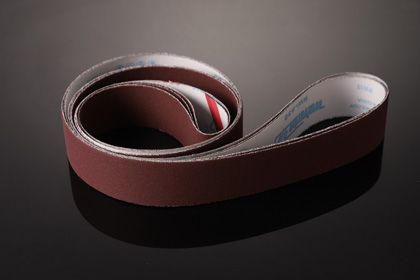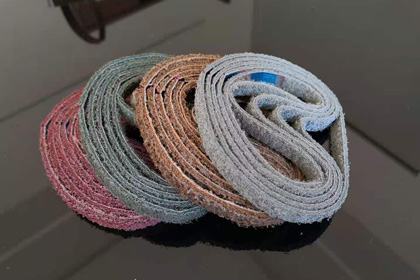Abrasive belts are widely used in various industries for grinding, sanding, and finishing operations. This type of abrasives wholesale is made of various abrasive materials, backing types, and grit sizes to suit different applications. Here are some common types of sanding belts for sale:

The poly-cotton Jwt RMC aluminium oxide abrasive belts AJ25 with calcined aluminum oxide, is flexible, high wear-resistant and high strew grains density.
Read More RMC silicon carbide coated abrasive belt CJ25 uses Jwt poly-cotton cloth and silicon carbide, making it flexible, high wear-resistant and high coating density.
Read More RMC abrasive belts for metal backing is Jwt flexible and high wear-resistant cloth.
Read More RMC sanding belt for wood adopts all-polyester cloth base and all-resin processing so that this abrasive cloth has good stiffness and toughness.
Read More 
Non woven abrasives is mainly designed to work in a belt form. The particular structure makes it very flexible and prevents delamination.
Read More Professional Expertise and Reputation: RMC is one of the most professional abrasive belt manufacturers in China, specializing in the manufacture and supply of high-quality abrasive belts for various industrial applications. With many years of experience in the abrasive industry, RMC has developed an excellent reputation for producing top-quality abrasive products that meet the needs of customers worldwide.
Advanced Technology and Premium Materials: At RMC, we use advanced technology and premium raw materials to produce our abrasive belts. Our sanding belt types are made of high-quality abrasive grains, sturdy cloth backing, and advanced bonding technology, ensuring maximum durability and long-lasting performance. We offer a wide range of abrasive belts with different grits, sizes, and backing types to suit various applications and requirements.
Exceptional Customer Service and Support: As one of the most considertive abrasive sanding belts suppliers, our company is committed to providing our customers with exceptional service and support. Our team of experts is always available to answer any questions and provide technical assistance. We also offer fast and efficient shipping and delivery to ensure that our customers receive their orders on time.
Commitment to Environmental Sustainability: In addition to our high-quality products and excellent service, RMC also prioritizes environmental protection and sustainability. We use eco-friendly materials and production processes to minimize our impact on the environment.
Sanding belts are commonly applied to handheld belt sanders and benchtop sanders. As one of leading abrasive sanding belts suppliers, our abrasive sanding belts are available in a wide range of sizes and grits, which determines their level of abrasiveness. Coarser grits are used for removing material quickly, while finer grits are used for smoothing and finishing surfaces.
RMC's sanding belts are outstanding for applications such as:
Woodworking: Abrasive belts for sale are commonly used in woodworking to smooth rough surfaces, remove stains, and prepare wood for staining or painting.
Metalworking: Sanding belts can help to remove rust, paint, and other coatings, as well as to smooth and shape metal surfaces.
Automotive: Some sanding belt types are used in automotive repair to smooth out bodywork and to prepare surfaces for painting.
Construction: Abrasive belts for sale can also be used to smooth out surfaces of concrete, stone, and other building materials.
To be an effective grinding tool, splicing sanding belts must have good joints. The joints are divided into two types: lap joint and butt joint. In the two joint modes, the lap joint is the main one, but the gasket joint is developing rapidly and has a trend to replace the lap joint. It's important for abrasive belt manufacturers to choose the correct joint for your custom sanding belts – and perhaps more importantly – to choose an abrasives supplier who can make very strong, durable belts with proper jointing methods and quality assurances.
There are several standard sanding belt sizes available in the market. Here are the most common ones:
| Sanding Belt Size | Common Use Cases |
| 1 x 30 sanding belt | Small woodworking projects and detail sanding |
| 3 x 21 sanding belt | Medium-sized woodworking projects |
| 3 x 24 sanding belt | Handheld belt sanders, larger areas of wood, metal, or other materials |
| 4 x 24 sanding belt | Handheld belt sanders, larger areas of wood, metal, or other materials |
| 6 x 48 sanding belt | Large industrial sanders, large flat surfaces like tabletops or doors |
| 6 x 89 sanding belt | Large industrial sanders, large flat surfaces or heavy-duty sanding applications |
The "best" abrasive sanding belts depend on the specific application, the type of material being sanded, and the desired finish. Here are some general guidelines for choosing the best sanding belt:
Different abrasive materials are suitable for different applications. For example, aluminum oxide is a versatile and durable abrasive that is suitable for general purpose sanding, while zirconia alumina is more aggressive and long-lasting and is best for heavy-duty sanding applications.
The backing material can affect the performance and durability of the sanding belt. For example, a cloth backing is more flexible and is suitable for contour sanding, while a stiffer paper or polyester backing is better for flat surfaces.
The grit size determines how coarse or fine the sanding belt is. A coarser grit is best for removing material quickly, while a finer grit is better for finishing and polishing.
The best abrasive sanding belts for wood will depend on the specific task at hand, as well as the type of wood being sanded. However, there are some general guidelines that can be followed when choosing a sanding belt for wood.
For most wood sanding applications, a medium grit sanding belt (between 80-120 grit) is a good choice. This grit size will allow you to remove any rough spots or imperfections, without causing excessive damage to the wood. For finer finishing work, a fine grit sanding belt (between 150-220 grit) can be used.
Aluminum oxide sanding belts are a good choice for wood sanding, as they are durable and long-lasting. Silicon carbide belts can also be used, but they tend to be more expensive and are better suited for harder materials like metal.
Cloth-backed sanding belts are a good choice for wood sanding, as they are more flexible and conform to the contours of the wood better than paper-backed belts.
In summary, when choosing a sanding belt for wood, it is important to consider the grit size, material, backing material, and brand to ensure that you get the best results for your specific task.

We are passionate about professional abrasive solutions for industry and trades.
No. 61, Qinfen Road, Xinbei District, Changzhou, Jiangsu Province, China.